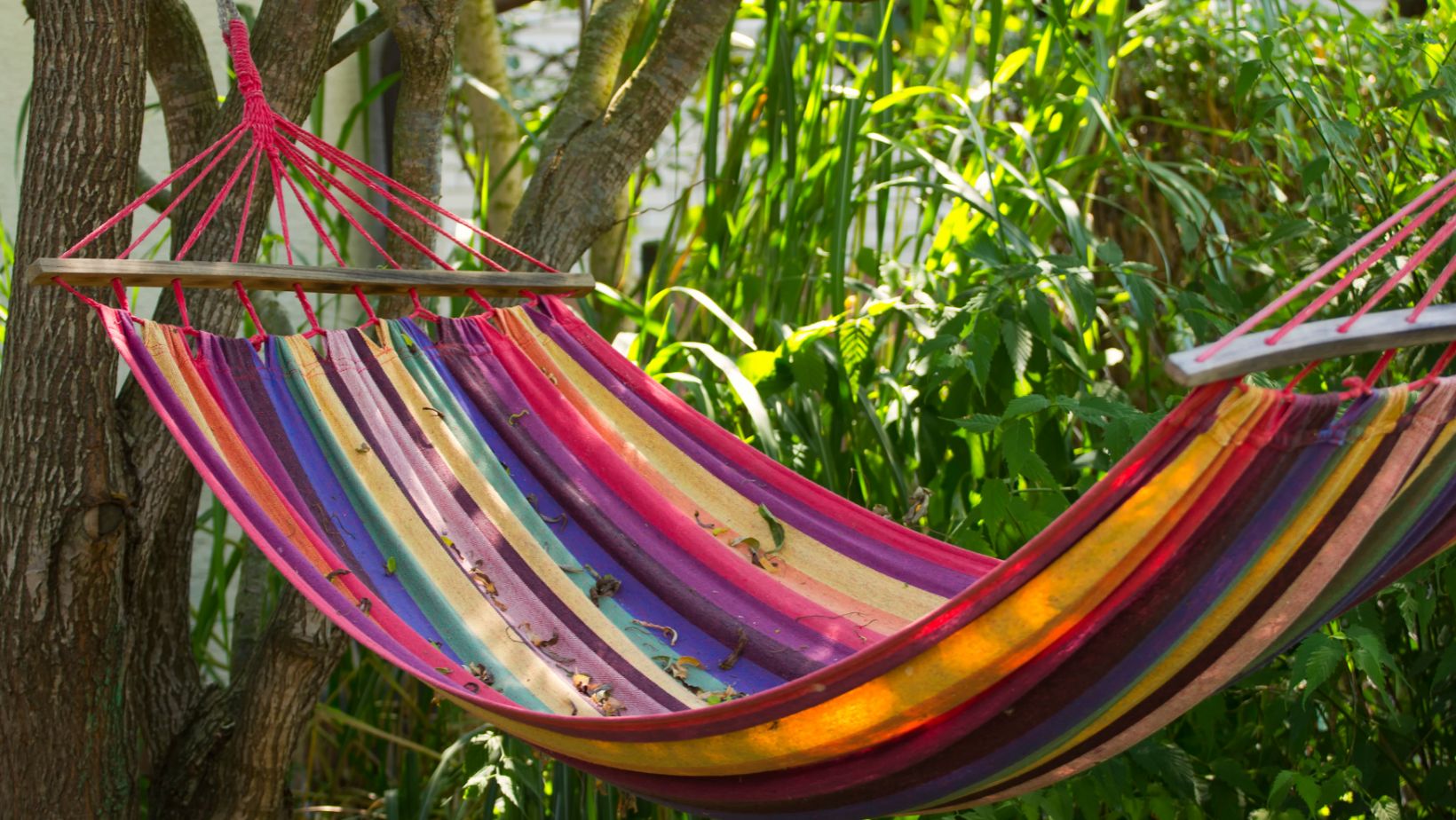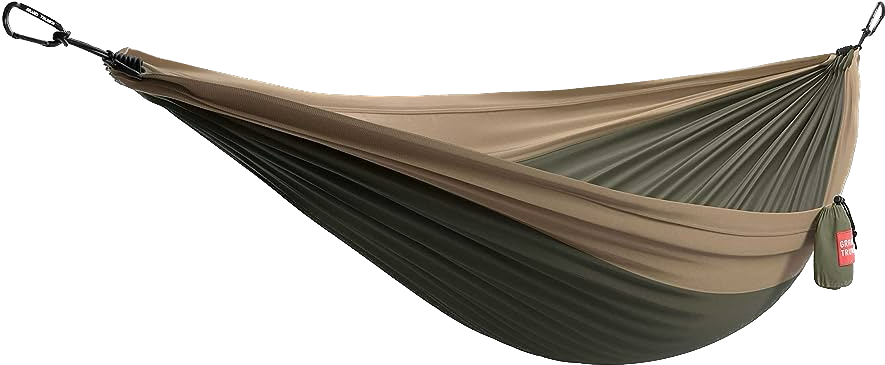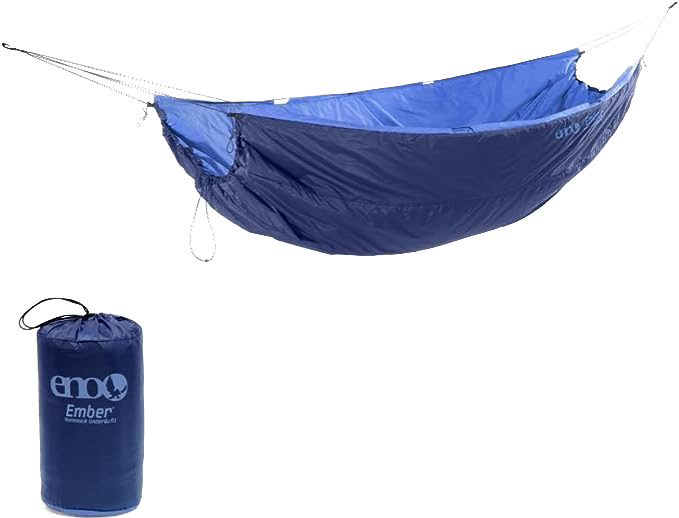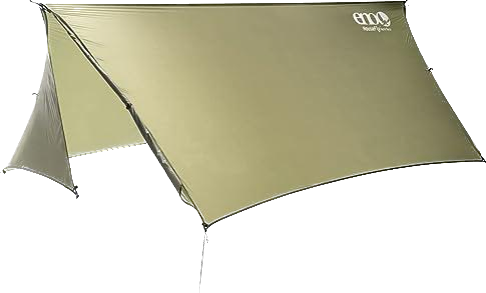Hammocks, like any other outdoor furniture, can accumulate dirt, and debris. If left long enough they begin to produce a musk or smell and develop mold or mildew. But worry not, we’ve got you covered. In this guide on how to clean a hammock, we’ll walk you through the process of washing hammocks. We’ll cover inspection and preparation, cleaning methods, drying, and storage, helping your hammock stay a comfortable, clean, and good-smelling place to lay and relax.
Short Summary
- Inspect the hammock for damage before cleaning.
- Remove accessories and shake out dirt prior to washing.
- Follow the manufacturer’s directions when selecting the right cleaning method, pre-treating stains, washing, rinsing & drying. Also properly store in a breathable fabric bag or weather-tight tote away from direct sunlight and dampness.
Preparing Your Hammock for Cleaning
Before diving into the cleaning process, let’s talk about how to prepare your hammock. This step is often overlooked but pretty important as it will help you avoid doing any additional damage to the hammock and gear during washing. Proper preparation involves three key steps: inspecting for damage, removing accessories, and shaking out dirt and debris.
Inspecting for Damage
First and foremost, inspect your hammock for any signs of damage before cleaning. Before and after every use you should be checking your hammock and gear for any holes, tears, fraying, or stretched fabric. Depending on the cleaning method, you could make things worse if you don’t repair or patch the hammock before cleaning.
Some of the most common places for damage include the following:
- Holes or stretching near the foot of the hammock. Typical for those who wear shoes in their hammock.
- Stretching or fraying in the center of the hammock. Most common after extended use and normal wear and tear.
- Tearing or fraying near the attachment points of the hammock.
- Stretched-out fabric or thinning on the edges of the hammock.
- Damaged strands or fraying in rope or woven hammocks.
If you do find any issues with your hammock, you’ll want to properly repair it prior to washing it. Especially if you plan on having it machine washed and throwing it in the dryer. Hand washing is definitely easier on your gear and allows you to avoid any damaged areas. We’ll cover more below.
Preparing your Hammock for Wash
Before you begin cleaning your hammock, shake out any dirt, debris, food crumbs, and sand that may have accumulated. If there is any dirt or food stuck to the hammock, use a dry, soft-bristled brush to gently lift away any surface dirt or debris from both sides of the hammock.
After brushing, lift the hammock and give it a vigorous shake to remove any remaining dirt and debris. This step will make the actual cleaning process more effective and prevent dirt particles from being grounded into the fabric during washing.
Next, you should remove any attachments or accessories. This includes the spreader bar if your hammock has one and any metal carabiners or attachments. You’ll want to hand scrub these separately. Once everything is removed and ready, you can follow the recommended washing method provided by the manufacturer.
Cleaning your Hammock – Machine wash vs Hand Wash

Now that your hammock is ready for cleaning, it’s time to choose between machine washing vs handwashing. Some types of hammocks are able to handle the added stress from machine washing, whereas some should only be hand washed. To help decide which cleaning method is best for you, we’ve provided a table down below.
| Hammock Material | Machine Washable | Tumble Dry Safe |
|---|---|---|
| Cotton or Fabric | Yes | Yes |
| Rope | Some | No |
| Camping | Some | Some |
| Quilted | Yes | No |
| Hammocks with Spreader Bars | Some | Some |
| Hammock Straps | No | No |
Please note that the “Some” in the columns indicate that it may vary depending on the specific manufacturer’s instructions. Always refer to the care instructions provided by the hammock manufacturer for the most accurate cleaning guidelines.
Rope Hammocks
Rope hammocks are a classic and popular choice, but they require special care when cleaning. To clean your rope hammock, start by filling a small pool or tub with water and soaking the hammock in it. Be sure to avoid submerging any O-rings, chains, and spreader bars, as this can lead to rusting or mildew growth.
Apply warm soapy water and gently scrub away stains with a soft bristle brush. Rinse the rope hammock thoroughly. Hang it out to dry.
Fabric Hammocks
Fabric hammocks with spreader bars require a slightly different cleaning approach. First, use a soft-bristled brush on both sides of the hammock to remove stains and dirt, then shake off any debris.
You can then either machine wash it on a gentle cycle in cold water or hand wash it in a bucket with a mild detergent. Avoid using bleach or fabric softeners, as they can damage the fabric.
If your fabric hammock has removable spreader bars, make sure to remove them before washing.
Camping Hammocks
Camping hammocks are designed to be lightweight and portable, making them perfect for outdoor adventures. To clean your camping hammock, it’s best to gently hand wash with a mild detergent and a soft-bristled brush. Before washing, remove any metal hardware to avoid damage.
After washing, hang your camping hammock in a well-ventilated area for immediate drying.
Quilted Hammocks
Quilted and woven hammocks are known for their comfort and style but require gentle hand cleaning to maintain their appearance. Use a mild detergent and lukewarm water to wash your quilted hammock. For drying, hang your hammock in a well-ventilated area, and avoid direct exposure to sunlight.
Proper care for your quilted hammock will ensure it remains a cozy and inviting place to relax.
The Cleaning Process
With the right cleaning method chosen, it’s time to dive into the actual cleaning process. This involves pre-treating stains, washing the hammock, rinsing thoroughly, and drying the hammock. Following these steps will ensure your hammock remains clean and comfortable for many relaxing moments to come.
Let’s break down each step in more detail.
Pre-treating Stains
Stains can be stubborn, but pre-treating them can make all the difference. One common trick I use is to apply baking soda paste on stained areas. All you’ll do is mix baking soda with a little water to form a paste. Then you simply apply the paste, wait for about 5 minutes, and then wipe gently. This will help to lift the stain and make it easier to remove during the washing process.
Hydrogen peroxide can be used to remove stubborn spots or mildew stains. Use a toothbrush to scrub away the spores for the best results.
Washing the Hammock
When it comes to washing hammocks, avoid using washing machines with agitators, as they can cause damage. Instead, I recommend hand washing or using a machine without an agitator.
If you do decide to use a washing machine without an agitator, add a gentle detergent, and follow the manufacturer’s directions for the appropriate cycle and temperature settings.
If you’re hand washing hammocks, use a mild detergent and lukewarm water, gently scrubbing the hammock to remove dirt and stains. Be sure to avoid bleach and fabric softeners, as they can damage the fabric.
Rinsing Thoroughly
After washing your hammock, rinse it thoroughly with fresh water and make sure to remove any soap residue. If you don’t remove all the soap residue, it could cause irritation to your skin the next time you lay in it. If you used a washing machine, this is easy as it should rinse everything out for you. If you’re hand-washing hammocks, simply run it under a faucet or use a garden hose to rinse it all down.
Drying the Hammock
Once your hammock is washed and rinsed, it’s time to dry it. The best way to dry your hammock is to hang it outside. Try to find somewhere shady. If left in the sun this could cause the hammock to fade or weaken. If you don’t have access to outdoor space, you can also spread it out on a tabletop to dry in the air. I recommend avoiding using machine dryers, as they can cause damage to the fabric. However, there are some that have been made to handle a tumble dryer so check your manufacturer’s tag.
Lastly, make sure your hammock is completely dry before storing or using it again. This will prevent mildew growth and keep your hammock fresh and comfortable.
Cleaning Hammock Accessories

Your hammock’s accessories, such as spreader bars and ropes, also need attention and care to ensure your hammock remains in good condition. Regular cleaning and maintenance of these accessories will help extend their lifespan and keep your hammock looking and functioning at its best.
In this section, we’ll discuss how to care for your hammock accessories, including cleaning spreader bars and washing hammock straps.
Cleaning Spreader Bars
Spreader bars, especially wooden ones, require regular care and cleaning to maintain their appearance and function. To clean your spreader bars, wipe them down with a mild detergent and clean water solution, followed by rinsing with a dampened clean cloth to remove any residual detergent.
To ensure the longevity of the wooden spreader bars on your rope hammock, inspect the wood regularly and refresh the finish when it appears dull and faded.
Washing Hammock Straps or Rope
Just like hammocks, over time hammock straps get dirty and need to be cleaned. I recommend hand washing rather than machine washing hammock straps. Hammock straps are typically made of strong and durable materials such as nylon or polyester webbing, and they are often exposed to significant stress and tension during use. Machine washing can potentially damage the straps, weaken their structural integrity, or cause fraying.
To clean hammock straps, it’s generally best to follow these steps:
- Spot cleaning: If there are specific stains or spots on the straps, use a mild detergent or soap and a soft brush or cloth to clean those areas. Gently scrub the affected spots and rinse thoroughly.
- Hand washing: Fill a basin or tub with cold water and add a small amount of mild detergent. Submerge the straps and agitate them gently by hand to clean them thoroughly. Rinse the straps with clean water to remove any soap residue.
- Air drying: After cleaning, hang the hammock straps in a well-ventilated area to air dry. Avoid direct sunlight or heat sources as they can potentially weaken or damage the straps.
Additionally in the outdoors, hammock straps can get attract sap. Follow these 3 steps to properly clean hammock straps and remove sap.
- Ice Pack Method: If the sap is still sticky or fresh, you can try the ice pack method. Place ice cubes in a plastic bag and hold them against the sap on the straps. Let it sit for a few minutes until the sap hardens.
- Scrape Gently: Once the sap has hardened, use a blunt edge, such as a plastic card or a spoon, to gently scrape off the sap from the straps. Be careful not to apply too much pressure to avoid damaging the straps.
- Spot Cleaning: If there is any residual sap after scraping, you can apply a small amount of rubbing alcohol or a specialized sap remover to a damp cloth or cotton ball. Gently dab the affected area to dissolve the sap. Rinse with water and allow the straps to air dry completely.
Note: It’s always a good idea to test any cleaning solution or method on a small, inconspicuous area of the straps first to ensure it does not cause any damage or discoloration.
Proper Hammock Storage
Proper hammock storage is essential to maintaining the longevity and comfort of your hammock. When storing your hammock, place it in a breathable, weather-resistant fabric bag and store it indoors, away from direct sunlight and dampness. If storing your hammock in a garage or shed, use a weather-tight tote and keep it high to avoid rodents.
Additionally, there are different methods for storing hammocks with and without spreader bars, as we will discuss in the following subsections.
Storing Without a Spreader Bar
If your hammock doesn’t have a spreader bar, you can simply hang it in a well-ventilated area indoors for storage. Alternatively, you can use a breathable bag designed for hammock storage, which will protect your hammock from dust and other potential damage.
Proper storage will ensure your hammock stays clean, fresh, and ready for use whenever you need it.
Storing With a Spreader Bar
For hammocks with spreader bars, the storage process may be slightly different. To store a hammock with a spreader bar, you can roll the hammock into a tube shape, place it in a breathable bag, or hang it in a well-ventilated area. Additionally, store the wooden spreader bars by keeping them in a dry place.
Summary
In conclusion, proper care and maintenance of your hammock are essential to ensuring its longevity and comfort. By following the steps outlined in this guide, you’ll be able to clean your hammock, care for its accessories, and store it properly, ensuring it remains a comfortable and inviting haven for many relaxing moments to come. So go ahead, enjoy your hammock, and let it take you away to a world of relaxation and tranquility, knowing that it’s well cared for and ready to provide you with the ultimate comfort experience.
Frequently Asked Questions
How do you clean an outdoor rope hammock?
To clean your outdoor rope hammock, first, give it a good hose down to remove excess dirt. Then mix some mild liquid detergent with warm water and use a soft bristled brush to scrub away any remaining dirt or debris.
After washing, hang up the hammock and let it air dry in the shade out of the sun.
Can I wash my cotton hammock?
Yes, you can wash your cotton hammock but only hand wash. Fill the sink with warm water, add some shampoo, and knead the hammock well in this washing water. Drain the wash water and use warm water from the tap to thoroughly wash the shampoo out of the hammock.
Wring out the hammock well and leave it spread out over the clothes horse to dry.
Can you put a rope hammock in the washing machine?
In general, it is safe to wash your rope hammock in a washing machine if you use the gentle cycle with cold water and mild detergent or shampoo. Before placing your hammock in the washing machine, tie the ends together to prevent tangling, and make sure to use a mesh laundry bag.



 Hello there, we're Vira Outdoors!
Hello there, we're Vira Outdoors!

